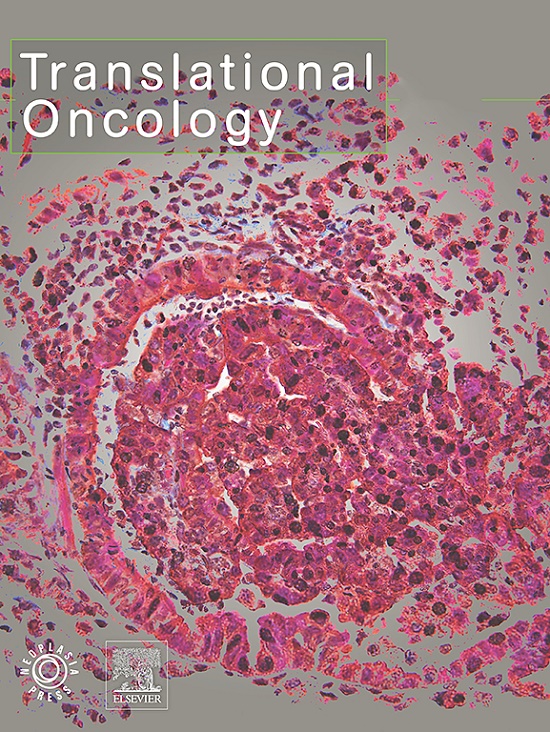ERβ调节的circATP2B1/miR-204-3p/TWIST1正反馈回路促进透明细胞肾细胞癌的上皮细胞向间质转化
IF 5
2区 医学
Q2 Medicine
引用次数: 0
摘要
背景我们以前的研究表明,雌激素受体β(ERβ)可通过下调circATP2B1和miR-204-3p的表达促进透明细胞肾细胞癌(ccRCC)的进展。在这里,我们发现ERβ可能通过调节circATP2B1/miR-204-3p/TWIST1(Twist family basic helix-loop-helix transcription factor 1)信号通路促进ccRCC的上皮-间质转化(EMT)。采用免疫组化、实时定量聚合酶链反应和免疫印迹法检测 TWIST1 在 ccRCC 组织和细胞中的表达。染色质免疫沉淀试验验证了 ERβ 和 TWIST1 之间的关系。荧光素酶报告基因实验验证了 TWIST1 和 miR-204-3p 的结合靶点。通过体外和体内实验研究了 TWIST1 在 ccRCC 中的作用。结果机理分析表明,miR-204-3p 可以通过靶向 TWIST1 的 3′ 非翻译区来抑制 TWIST1。此外,TWIST1 还能直接与 ERβ 启动子区的转录因子结合位点结合,形成正反馈环,从而促进 ERβ 的转录。这些体外数据在体内小鼠模型中得到了进一步验证。结论我们的研究结果表明,ERβ/circATP2B1/miR-204-3p/TWIST1可通过形成正反馈环路促进EMT,从而促进ccRCC的进展。靶向这条新发现的信号通路可能会更有效地控制ccRCC的进展。本文章由计算机程序翻译,如有差异,请以英文原文为准。
ERβ-regulated circATP2B1/miR-204–3p/TWIST1 positive feedback loop facilitates epithelial to mesenchymal transition in clear cell renal cell carcinoma
Background
Our previous studies have shown that estrogen receptor beta (ERβ) can promote the progression of clear cell renal cell carcinoma (ccRCC) by downregulating the expression of circATP2B1 and miR-204–3p. Here, we found that ERβ might promote the epithelial-mesenchymal transition(EMT) of ccRCC by modulating the circATP2B1/miR-204–3p/TWIST1(Twist family basic helix-loop-helix transcription factor 1) signaling pathway.
Methods
We utilized bioinformatics analysis to determine the clinical significance of TWIST1 in ccRCC. The expression of TWIST1 in ccRCC tissues and cells was examined using immunohistochemistry, real-time quantitative polymerase chain reaction and western blotting assay. Chromatin Immunoprecipitation assay were conducted to validate the relationship between ERβ and TWIST1. Luciferase reporter gene assays were employed to validate the binding targets of TWIST1 and miR-204–3p. The role of TWIST1 in ccRCC was studied through in vitro and in vivo experiments. Transwell assays and wound healing assays were used to assess the impact of TWIST1 on the invasive and migratory abilities of ccRCC cells.
Results
Mechanism analysis revealed that miR-204–3p can inhibit TWIST1 by targeting its 3′ untranslated region. Additionally, TWIST1 can promote ERβ transcription by directly binding to transcription factor binding site in the ERβ promoter region, forming a positive feedback loop. These in vitro data were further validated in an in vivo mouse model. Importantly, analysis of data from the TCGA-KIRC database further confirmed the above in vitro/in vivo findings.
Conclusions
Together, our results suggest that ERβ/circATP2B1/miR-204–3p/TWIST1 can promote EMT by forming a positive feedback loop, thus promoting the progression of ccRCC. Targeting this newly identified signaling pathway may more effectively control the progression of ccRCC.
求助全文
通过发布文献求助,成功后即可免费获取论文全文。
去求助
来源期刊

Translational Oncology
ONCOLOGY-
CiteScore
8.40
自引率
2.00%
发文量
314
审稿时长
54 days
期刊介绍:
Translational Oncology publishes the results of novel research investigations which bridge the laboratory and clinical settings including risk assessment, cellular and molecular characterization, prevention, detection, diagnosis and treatment of human cancers with the overall goal of improving the clinical care of oncology patients. Translational Oncology will publish laboratory studies of novel therapeutic interventions as well as clinical trials which evaluate new treatment paradigms for cancer. Peer reviewed manuscript types include Original Reports, Reviews and Editorials.
 求助内容:
求助内容: 应助结果提醒方式:
应助结果提醒方式:


